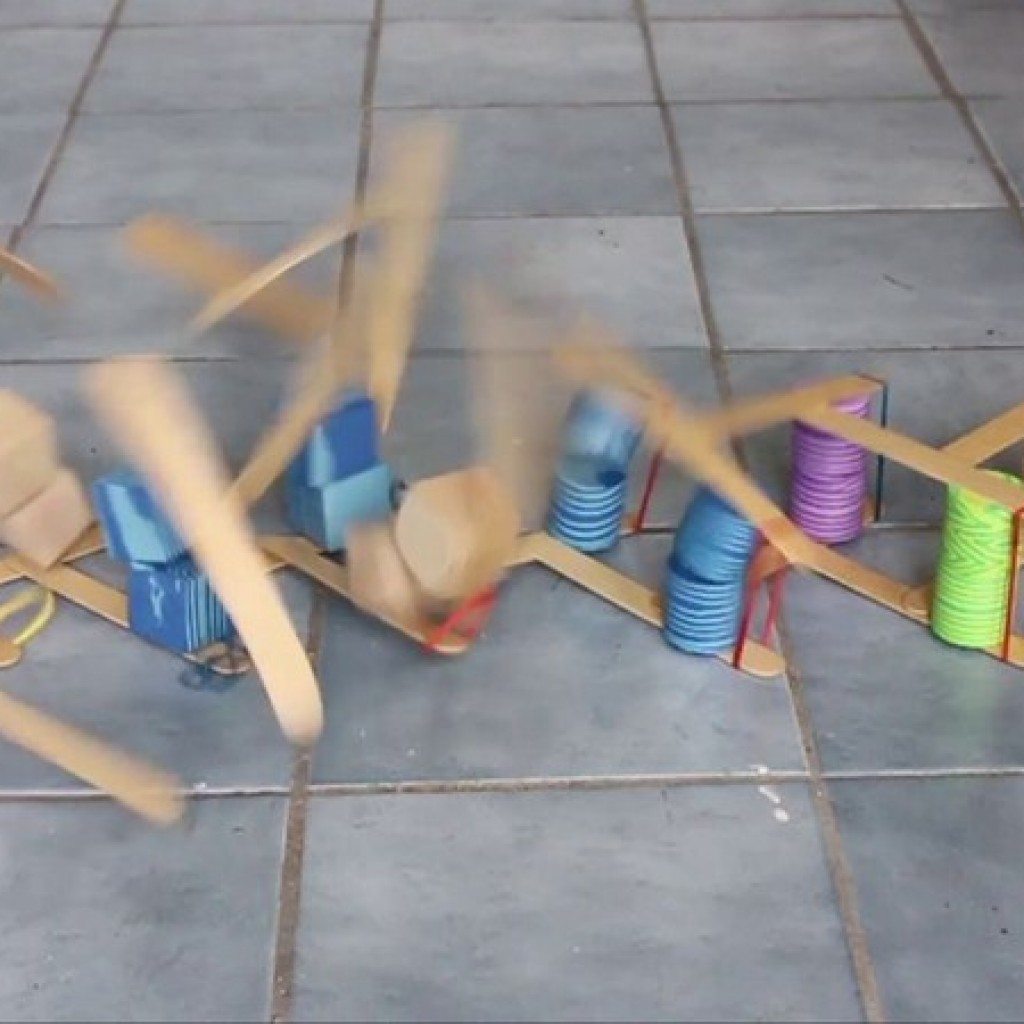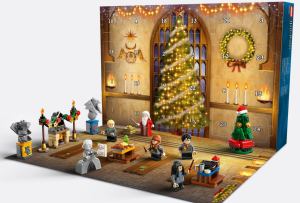Last Updated on October 29, 2024 by Team Ideas24

Repeat this process until the chain reaches the desired length. The sticks should all intersect at the ends or the 1/3 point on the stick. To lock down the end of the chain, insert one last sick between the three end pieces.
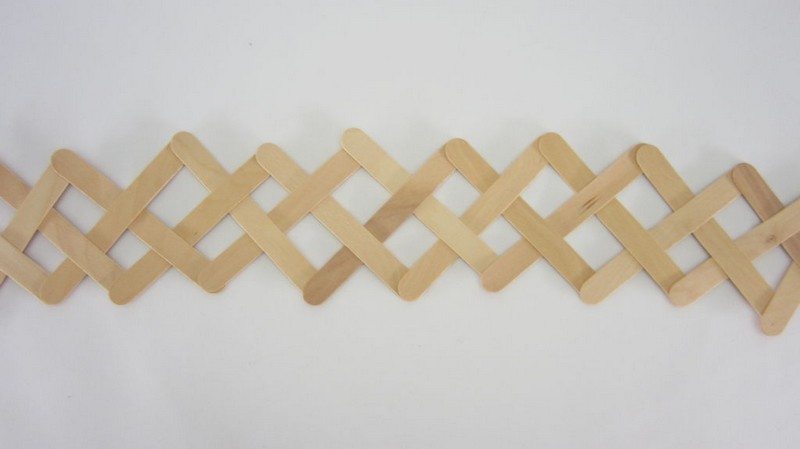
This weave can be easily curved by carefully bending a straight section of the chain.
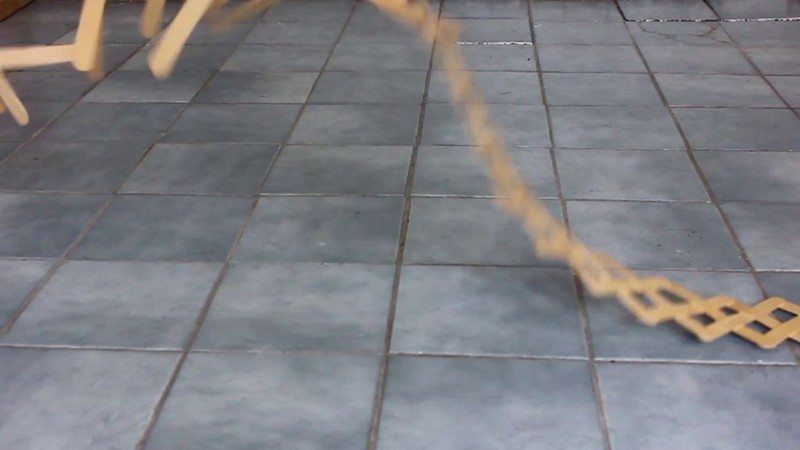
To detonate the chain, simply pull out the last piece that you added. The chain should lift up off the ground and travel like a wave until all the pieces have flown apart.
Clever Levers

Interwoven sticks can store a surprising amount of energy. But you can get even more explosive force by adding rubber bands. “Clever Levers” is the easiest configuration to do for this.

Two sticks are placed on either side of a block. Then rubber bands are placed around the sticks on one side of the block.

This pulls one end of the sticks together and the opposite end apart. To hold the sticks together, the free end can either be held in place by weight or by placing the end of the sticks between another set of clever levers.
To make a chain reaction bomb out of clever levers, arrange them so that the free end (the side that wants to pull apart) of each lever is fit between the sticks of another clever lever.

This can be continued in a long series to make a chain reaction bomb. More rubber bands can be added to increase the explosive force.
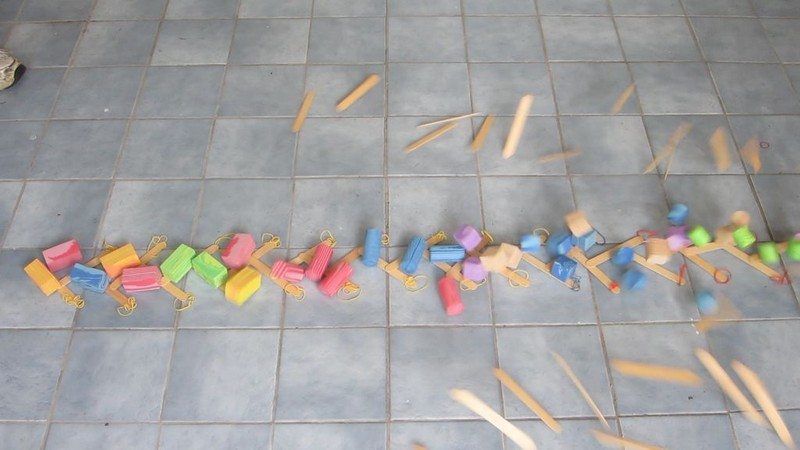
Additional props such as plastic cups and ping pong balls can be added on top of the lever for greater effect. When the lever detonates, these props will be thrown into the air creating a much bigger visual display.
How about challenging them to come up with their own chain-reaction stick bombs? :)
Source: DIY Hacks and How Tos
Understanding Energy Types in Popsicle Stick Chain Reactions
When you create a popsicle stick chain reaction, you’re not just building a fun project—you’re also engaging with fundamental physics concepts like potential and kinetic energy. Stick bombs, as they’re often called, illustrate these energy types in a dynamic and visually impressive way. This activity is an accessible way to understand how energy can be stored and released, transforming into movement and force.
Below, we explore how potential and kinetic energy play essential roles in creating an explosive popsicle stick chain reaction.
Potential Energy in Stick Bombs
Potential energy is the stored energy within an object, waiting to be released. In a popsicle stick chain reaction, potential energy accumulates as each stick is woven and bent into place, creating tension. This tension, which is the basis of all stick bombs, is generated as each popsicle stick is carefully placed over the previous one and then pinned beneath the next.
This creates a powerful buildup, as every stick in the chain holds energy just waiting to escape. When the final stick is released, the stored potential energy quickly transforms, sending the sticks flying in a burst of kinetic energy.
The Burst of Kinetic Energy in a Chain Reaction
Kinetic energy is the energy of motion, activated the moment the chain reaction is triggered. With a stick bomb, pulling out one stick releases the potential energy in a rapid chain reaction. This energy moves along the length of the popsicle stick chain, releasing tension in each stick and propelling them upward.
The sudden shift from stored energy (potential) to active energy (kinetic) creates the iconic “wave” effect, where each section of the chain jumps and twists, demonstrating the raw force of kinetic energy in motion. Stick bombs vividly show how potential energy can be unleashed into powerful kinetic energy.
Why Energy Types Matter in Popsicle Stick Chain Reactions
Both potential and kinetic energy are essential to making a successful popsicle stick chain reaction. Without proper tension and arrangement of the sticks, a stick bomb would not work, as the potential energy wouldn’t build effectively.
Understanding how these energy types interact can help you experiment with different stick bomb designs and create variations with greater explosive power or longer chain reactions. So, every time you set up a stick bomb, you’re building a simple yet impressive display of energy transformation in action, making popsicle stick chain reactions both fun and educational.
Tips for Filming in Slow Motion
Capturing a popsicle stick chain reaction on video brings an extra level of excitement to your stick bomb project. With the right setup, you can highlight the intricate motion and energy release as the sticks explode outward. Here’s how to make sure your stick bomb video captures every thrilling detail in slow motion.
1. Use the Right Slow Motion Settings
Most smartphones and cameras have slow-motion settings that can make your popsicle stick chain reaction look impressive. For filming stick bombs, select a frame rate between 120 and 240 frames per second (fps). Higher fps will slow down the action even more, allowing you to see each stick’s movement as the chain unfolds. Check your camera’s settings to ensure you’re using the maximum frame rate available for smooth slow-motion playback.
2. Find the Ideal Lighting
Proper lighting is essential for filming your popsicle stick chain reaction, as slow-motion videos require more light to avoid blurry footage. Filming outdoors on a bright day or near a window with lots of natural light works best for capturing clear details in your stick bomb video. If you’re indoors, use additional lighting like lamps or LED panels to eliminate shadows and bring out the action clearly.
3. Set Up Close and Wide Shots
Filming your stick bombs from multiple angles will add depth to your video. Position one camera close to capture the sticks’ detailed movement, and another camera farther back to capture the full effect of the popsicle stick chain reaction. This way, you can switch between detailed shots of the sticks in motion and wide shots showing the entire sequence, making your video more dynamic.
4. Stabilize Your Camera
Slow-motion filming is especially sensitive to camera shake, which can make your popsicle stick chain reaction video appear blurry. Use a tripod or place your camera on a stable surface to capture the entire stick bomb sequence without disruption. If you’re filming handheld, use a gimbal or stabilization feature on your camera to keep the frame steady.
5. Try Editing Techniques for Maximum Impact
Once you’ve captured your stick bomb in action, you can edit the footage to enhance the popsicle stick chain reaction’s visual appeal. Consider adding sound effects, adjusting the playback speed in certain parts, or including replay clips for the most explosive moments. These small edits can highlight the dramatic energy of your stick bomb and create an impressive final video.
With these tips, you’ll have all you need to create a memorable slow-motion video that showcases the energy and excitement of your popsicle stick chain reaction, turning a simple stick bomb project into a captivating visual experience.
Conclusion
Stick bombs offer a creative, hands-on way to explore energy and motion. Building these popsicle stick chain reactions provides valuable insights into potential and kinetic energy in a fun, interactive format. Each stick bomb allows you to experiment with different designs and modifications for varied effects. This project combines learning and enjoyment, making it ideal for DIY enthusiasts, students, and anyone curious about physics in action.
We have more fun experiments with your kids. Check out our DIY slime project!

